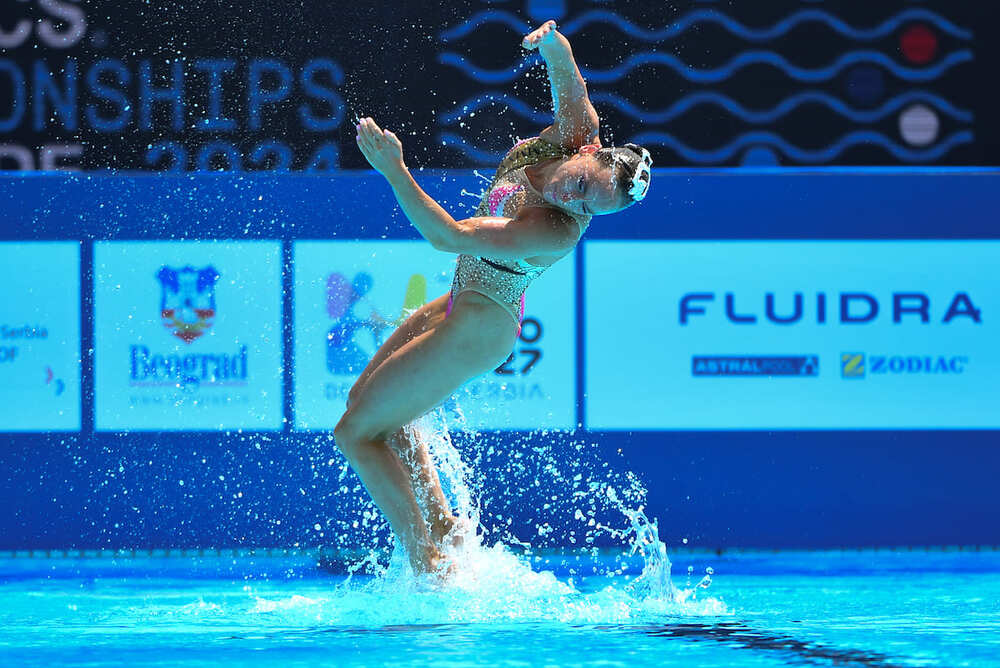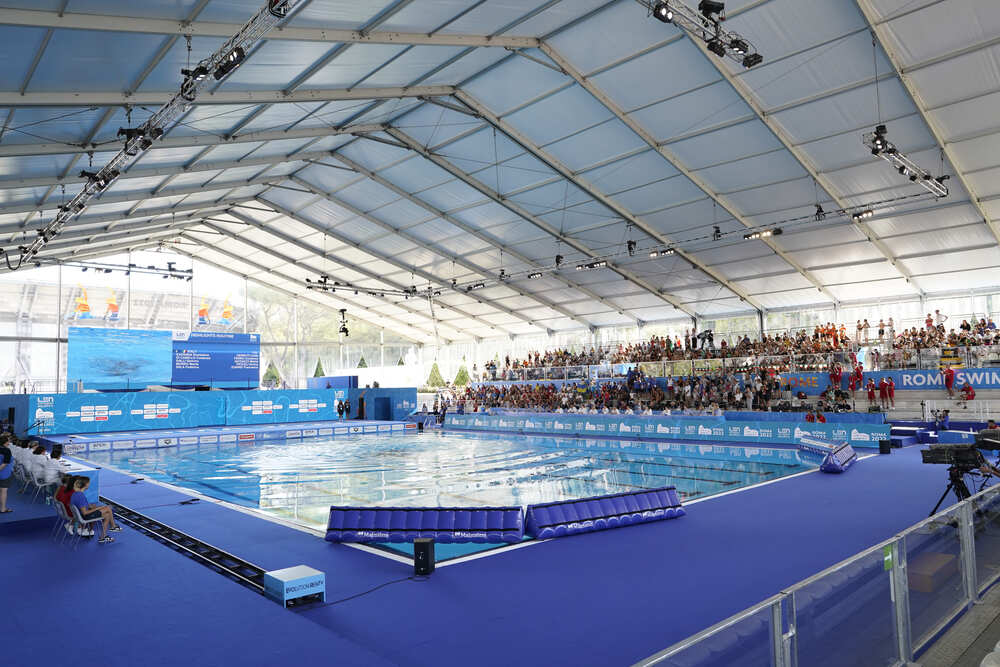Artistic swimming pools represent a specialized category of aquatic facilities designed specifically to support the unique demands of synchronized swimming competitions and training. As an industry professional, you need to understand that these pools differ substantially from traditional recreational or lap swimming facilities, requiring precise engineering to meet World Aquatics international standards.
Whether you’re planning a new aquatic center or adapting existing infrastructure, understanding the technical requirements for artistic swimming pools is essential for creating spaces that truly serve athletes and spectators alike.
This comprehensive guide will walk you through the critical design considerations, regulatory requirements, and innovative solutions that make artistic swimming pools successful.
You’ll discover how modular systems are revolutionizing pool construction and learn about the specific features that separate these specialized facilities from conventional swimming pools.
Dive deeper with the eBook
What is an Artistic Swimming Pool and What Makes it Different from Traditional Pools?
Artistic swimming pools are purpose-built or specially adapted aquatic facilities designed to support synchronized swimming, formerly known as synchronized swimming. These pools serve as performance venues where athletes execute choreographed routines that combine swimming, dance, and gymnastics elements. The primary distinction lies in their design focus on visibility, depth consistency, and acoustic requirements rather than purely recreational use.
Unlike leisure pools that prioritize comfort and accessibility for general swimming, artistic swimming pools must accommodate the specific needs of competitive performance. Athletes require unobstructed underwater visibility, consistent water depth across the entire surface, and specialized acoustic systems for musical synchronization. The pool environment must support complex choreographic movements while ensuring safety for athletes performing lifts, throws, and extended underwater sequences.
The regulatory framework governing these facilities extends far beyond standard pool construction codes. Competition-grade artistic pools must comply with strict World Aquatics specifications that cover everything from dimensional tolerances to water temperature control. These requirements ensure that athletes can perform at their peak level while judges can accurately assess routines from multiple viewing angles.

What Are the Official Dimensions and Standards for Artistic Swimming Pools?
World Aquatics outlines specific dimensional criteria necessary for the proper execution of the competition. Artistic swimming pools, whether they are modified Olympic pools or custom-built facilities for such events, must adhere to particular specifications regarding length, width, and depth.
For the routine segment of standard artistic swimming competitions, the pool should span at least 15 x 25 meters. Within this space, a 12 x 12 meter zone must feature a minimum depth of 3 meters. In the remaining sections, the depth must be no less than two meters. At the pool’s edge, the depth starts at two meters and gradually increases to three meters within 1.2 meters of the wall.
In Olympic Games and World Championships, the required size for the routine segment is a minimum of 30 x 20 meters, with a uniform depth of three meters across the entire pool.
There is also a requirement for elevated starting platforms measuring 0.7 meters in height (with an approximate tolerance of 1 cm) for Olympic and World Championship competitions. For standard events, the platforms must be between 0.5 and 0.7 meters high. In both instances, the width must be 4 meters, and the platform surface must be coated with a non-slip layer such as a fast-drying waterproof mat.
Another important guideline concerns water temperature regulation. During competitions, artistic swimming pools must be maintained at around 27°C (80.6°F) to promote ideal performance conditions and athlete comfort. The temperature must remain consistent throughout the pool volume, supported by heating and circulation systems that eliminate temperature layering and ensure even distribution.
Warm-up pools for artistic swimming athletes are also crucial to prepare before their routines. According to World Aquatics, these warm-up pools must have a minimum surface area of either 25 x 25 meters or 30 x 20 meters, with a depth of no less than 3 meters.
How Are Artistic Swimming Pools Designed to Support Athletic Performance?
Visibility represents the cornerstone of effective artistic swimming pool design, requiring uniform lighting systems that eliminate shadows and glare throughout the performance area. Professional installations utilize underwater LED lighting combined with overhead illumination to create consistent visibility for both athletes and judges. The lighting design must account for the reflective properties of water while providing adequate illumination for underwater photography and video recording during competitions.
Non-slip surfaces and accessibility features around the pool deck ensure athlete safety during entries, exits, and deck-based choreography elements. The pool edge design must accommodate artistic swimmers who frequently use the deck as part of their routines while providing secure footing for coaches and officials. Elevated platforms for judges and media personnel require careful integration into the facility design without compromising the acoustic or visual environment.
Acoustic design considerations extend beyond simple sound distribution to encompass both underwater and above-water audio systems. Synchronized choreography support requires speakers capable of delivering music underwater while maintaining clarity and synchronization with above-water sound. The pool shell design must account for sound transmission properties while preventing echo and reverberation that could disrupt musical timing.

Can Artistic Swimming Pools Be Temporary Structures?
Modular artistic pools offer significant advantages for facilities requiring flexible event hosting capabilities or facing budget constraints. Systems like Skypool allow for record-time construction, with a modular Olympic pool (50 x 25 x 2 m) taking as much as two months less time to manufacture and install compared to a concrete pool. These systems utilize prefabricated galvanized steel panels that can be rapidly assembled and disassembled as needed.
The benefits of temporary competition pools extend beyond construction speed to include lower long-term costs and enhanced flexibility for multi-use venues. Modular panel pools are ideal for hosting official competitions involving swimming, diving, water polo, and artistic disciplines, designed to meet the strict measurements and tolerances required by official organizations like World Aquatics. These installations can transform existing stadiums or arenas into world-class aquatic venues without permanent structural modifications.
Skypool system benefits include excellent corrosion protection, easy maintenance access, and complete compliance with World Aquatics regulations. Additionally, they can be installed in existing stadiums or arenas without the need to anchor them to the facility floor, and once the competition is over, the pool can be easily disassembled and return the space to its former purpose. This flexibility makes temporary installations attractive for venues that host multiple event types throughout the year.
What Materials and Construction Systems Are Used in Artistic Swimming Pool Projects?
Steel panel systems represent the most common approach for modular artistic swimming pool engineering, utilizing galvanized steel components that provide durability and precision assembly. Hot dipping in a zinc bath gives the galvanized steel panels excellent rust protection, ensuring durability and safety. These systems allow for millimeter-precise assembly while providing the structural integrity required for large-format competitive pools.
Waterproof membranes and liner systems must provide both excellent visibility and reliable waterproofing throughout the pool’s service life. Custom aquatic systems often incorporate specialized liner materials that resist chlorine degradation while maintaining optical clarity for underwater viewing. The membrane installation requires careful attention to seaming and anchoring details that prevent water migration while accommodating thermal expansion and contraction cycles.
Filtration and pumping systems for artistic swimming pools must maintain exceptional water clarity while supporting consistent depth across the entire pool surface. The circulation design requires multiple inlet and outlet points to prevent dead zones and ensure uniform water quality. Advanced installations include variable-speed pumping systems that can adjust circulation rates based on usage patterns while maintaining the precise water level control essential for competitive events.

Conclusions About Artistic Swimming Pools
Artistic swimming pools represent specialized aquatic facilities that require careful attention to design details, regulatory compliance, and performance optimization. The investment in these facilities pays dividends through enhanced competition hosting capabilities, athlete development opportunities, and community prestige. Whether you choose permanent construction or modular systems like Skypool, success depends on understanding the unique requirements that separate artistic swimming from conventional pool applications.
The future of artistic swimming pool design increasingly favors flexible, modular solutions that can adapt to changing needs while maintaining world-class performance standards. As World Aquatics continues to evolve competition requirements, facilities that invest in properly engineered artistic swimming pools will find themselves well-positioned to serve the growing global interest in this dynamic aquatic discipline.
Frequently Asked Questions
How much does it cost to build an artistic swimming pool? Costs vary significantly based on size, construction method, and local conditions. Modular systems like Skypool typically cost 20-30% less than traditional concrete construction while reducing installation time by 6-8 weeks for permanent installations.
What’s the difference between a competition artistic pool and a leisure pool? Competition pools require precise 30m x 20m dimensions, minimum 3-meter uniform depth, specialized lighting and acoustic systems, and compliance with World Aquatics regulations. Leisure pools prioritize comfort and accessibility over competitive performance requirements.
Can artistic swimming pools be used for other sports? Yes, these pools are ideal for water polo, diving training, synchronized swimming practice, and general competitive swimming. The dimensional requirements align well with multiple aquatic disciplines, maximizing facility utilization.
Are there modular solutions that meet World Aquatics standards? Yes, systems like Skypool and Myrtha Pools are certified to meet World Aquatics specifications. These modular solutions can be installed permanently or temporarily while maintaining full compliance with international competition standards.
Do artistic pools require special maintenance? These pools require enhanced attention to lighting systems, acoustic equipment, and water clarity maintenance. The specialized equipment and deeper water volumes may increase operational costs compared to conventional pools, but modern systems are designed for efficient operation.
